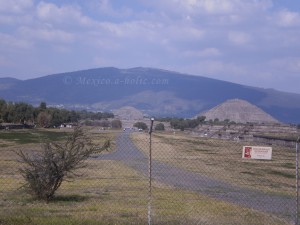 Teotihuacan, which in Nahuatl means City of the Gods or The place where gods are made is an ancient ceremonial center, one of the most important pre-Hispanic America due to its masterful urban layout, its monumental architecture and strong political and religious influence to other cities; it is also one of the most visited archaeological sites and values of Mexico, It is located in the municipality of San Juan Teotihuacan in the east of Mexico City. Teotihuacan was inscribed on the List of World Heritage by UNESCO in 1987. Through time, Teotihuacan has established itself as a sample of the best architectural style in Mesoamerica as well as a mystical center where, according to the pre-Hispanic followers of spiritual traditions, each 21st March there are powerful cosmic forces that are distributed to the four cardinal points, ideal time to renew the energy of the human body. more…
Teotihuacan, which in Nahuatl means City of the Gods or The place where gods are made is an ancient ceremonial center, one of the most important pre-Hispanic America due to its masterful urban layout, its monumental architecture and strong political and religious influence to other cities; it is also one of the most visited archaeological sites and values of Mexico, It is located in the municipality of San Juan Teotihuacan in the east of Mexico City. Teotihuacan was inscribed on the List of World Heritage by UNESCO in 1987. Through time, Teotihuacan has established itself as a sample of the best architectural style in Mesoamerica as well as a mystical center where, according to the pre-Hispanic followers of spiritual traditions, each 21st March there are powerful cosmic forces that are distributed to the four cardinal points, ideal time to renew the energy of the human body. more…
Tag-Archive for "UNESCO"
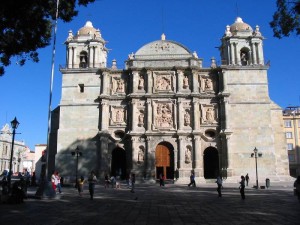 The city of Oaxaca is located in the southern region of Mexico and is the capital city of the state with the same name. In this city, tourists can admire the beautiful architecture of the buildings that adorn its historic center, declared World Heritage by UNESCO: the Cathedral, most important temple in the city, its construction began in 1535 and it was completed until 1574. Its facade has a baroque style with sculptures of Catholic saints that frame a beautiful relief in stone with the image of the Assumption of Mary. The Temple and ex-Convent of Santo Domingo de Guzman is considered one of the wonders of the city, it has ten chapels and a large dome decorated with 104 paintings of Dominican martyrs. The Constitution square has as main attraction the portals and a kiosk from the time of Porfirio Diaz in the XXth century. As well as the Basilica de la Soledad, the Macedonio Alcalá theatre, Government Palace, Alameda, among other magnificent colonial buildings. more…
The city of Oaxaca is located in the southern region of Mexico and is the capital city of the state with the same name. In this city, tourists can admire the beautiful architecture of the buildings that adorn its historic center, declared World Heritage by UNESCO: the Cathedral, most important temple in the city, its construction began in 1535 and it was completed until 1574. Its facade has a baroque style with sculptures of Catholic saints that frame a beautiful relief in stone with the image of the Assumption of Mary. The Temple and ex-Convent of Santo Domingo de Guzman is considered one of the wonders of the city, it has ten chapels and a large dome decorated with 104 paintings of Dominican martyrs. The Constitution square has as main attraction the portals and a kiosk from the time of Porfirio Diaz in the XXth century. As well as the Basilica de la Soledad, the Macedonio Alcalá theatre, Government Palace, Alameda, among other magnificent colonial buildings. more…
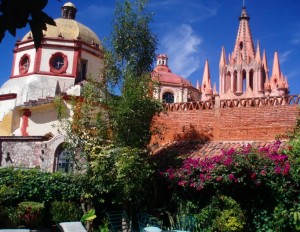 San Miguel de Allende is located in Guanajuato state. It is considered a “Pueblo Magico” (Magical Town) and it is considered Cultural Heritage of Humanity by the UNESCO; the distinction was awarded due to the cultural and architectural contribution to the Mexican Baroque and the importance of this city in the struggle for Independence of Mexico from Spain. The best way to enjoy San Miguel de Allende is walking down the cobblestone streets filled with colonial mansions and beautiful temples such as the Parish of St. Michael the Archangel and the Oratory of St. Philip Neri. more…
San Miguel de Allende is located in Guanajuato state. It is considered a “Pueblo Magico” (Magical Town) and it is considered Cultural Heritage of Humanity by the UNESCO; the distinction was awarded due to the cultural and architectural contribution to the Mexican Baroque and the importance of this city in the struggle for Independence of Mexico from Spain. The best way to enjoy San Miguel de Allende is walking down the cobblestone streets filled with colonial mansions and beautiful temples such as the Parish of St. Michael the Archangel and the Oratory of St. Philip Neri. more…
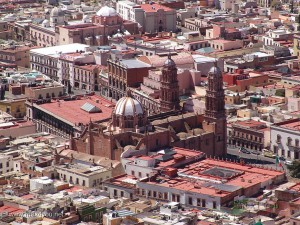 Zacatecas, which name means place where the grass is plentiful, was founded in 1546 and was originally named Mines of Zacatecas. Its mineral wealth gave strong revenue to the Spanish Crown, which made possible that this city receive the title of City of Our Lady of Zacatecas. This colonial city is located in the north central region of the Mexican Republic being one of the most beautiful cities in Mexico, thanks to its historical and architectural wealth was declared Cultural Patrimony of Humanity by UNESCO. In a walk through its narrow streets, alleyways and squares, the tourist will find a number of religious, civic and cultural buildings with a great beauty, tourist can also enjoy a trip on a the cable car. Zacatecas was one of the most important mining sites in the country, in fact, it houses “EL Eden” one of the main touristic mines which can be visited. more…
Zacatecas, which name means place where the grass is plentiful, was founded in 1546 and was originally named Mines of Zacatecas. Its mineral wealth gave strong revenue to the Spanish Crown, which made possible that this city receive the title of City of Our Lady of Zacatecas. This colonial city is located in the north central region of the Mexican Republic being one of the most beautiful cities in Mexico, thanks to its historical and architectural wealth was declared Cultural Patrimony of Humanity by UNESCO. In a walk through its narrow streets, alleyways and squares, the tourist will find a number of religious, civic and cultural buildings with a great beauty, tourist can also enjoy a trip on a the cable car. Zacatecas was one of the most important mining sites in the country, in fact, it houses “EL Eden” one of the main touristic mines which can be visited. more…
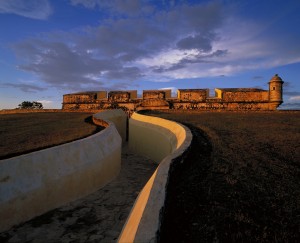 It is a historic fortified city on the shores of the Gulf of Mexico in the Yucatan Peninsula. It is renowned as one of the few walled cities in America and the only one in Mexico. One of the reasons it was declared Cultural Patrimony of Humanity by UNESCO in 1999 is the excellent condition of its historical heritage. The original Mayan settlement was called KaanPeech (In Mayan language: Kaan = snake, Peech = tick, which means: the place of snakes and ticks). When the Spanish arrived, they Hispanicized it to Campeche. After their arrival, the city became the largest port of colonial America, bringing an intense commercial traffic and subsequent construction of mansions and churches. However, the same wealth that allowed it to flourish attracted the attention of pirates whose expeditions not only led to endless stories, but that led to the lifting of impregnable fortifications that distinguish today’s place. more…
It is a historic fortified city on the shores of the Gulf of Mexico in the Yucatan Peninsula. It is renowned as one of the few walled cities in America and the only one in Mexico. One of the reasons it was declared Cultural Patrimony of Humanity by UNESCO in 1999 is the excellent condition of its historical heritage. The original Mayan settlement was called KaanPeech (In Mayan language: Kaan = snake, Peech = tick, which means: the place of snakes and ticks). When the Spanish arrived, they Hispanicized it to Campeche. After their arrival, the city became the largest port of colonial America, bringing an intense commercial traffic and subsequent construction of mansions and churches. However, the same wealth that allowed it to flourish attracted the attention of pirates whose expeditions not only led to endless stories, but that led to the lifting of impregnable fortifications that distinguish today’s place. more…
